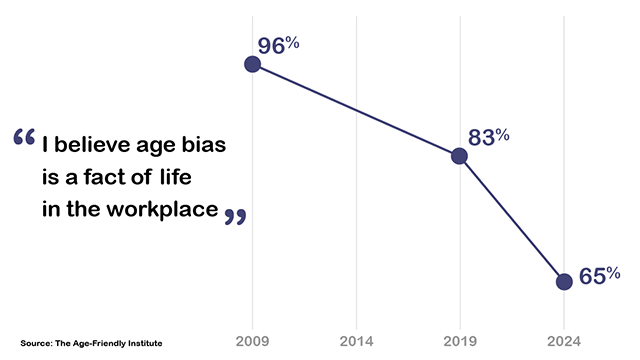Workplace Age Bias Still Prevalent, Yet Long Term Study Reveals Decline
From the perspective older adults in the workforce, age bias is considered a major obstacle, but that’s finally changing.

The Age-Friendly Institute operates an ongoing survey of a nationally representative sample of older adults age 50+ about age bias in the workplace. It began in 2009, and has included 12,127 respondents.
For over 15 years, the Age-Friendly Institute has been asking age 50+ Americans whether they believe age bias is a fact of life in the workplace. Their responses show a precipitous decline of over 30 percentage points -- from 96% saying 'yes' in 2009, to 65% in 2024.

Employers Are Changing Their Tune
The Age-Friendly Institute also interacts with hundreds of senior officers at employers worldwide. They have sought out the designation of Certified Age-Friendly Employer, and they are making changes to become attractive to this demographic. Age-Friendly Institute President Tim Driver acknowledges these age-friendly employers are still in the minority. But he calls them a vocal minority. “The ones that are proactively recruiting and retaining older workers are really into it. They are clear about the measurable benefits to their organization. Among such benefits, low turnover rates that drive up customer satisfaction, and cultural lifts when they include age in their diversity, equity, inclusion and belonging initiatives.” They’re recognizing that age-friendly workplaces and teams can improve bi-directional learning, employee engagement and performance. Today's older workers are healthier, more highly educated and making different choices about work, often opting to work longer as more flexibility allows them to adjust or reduce hours and work from home. With more older employees choosing to work longer and debunking a stereotype that age always negatively affects job performance, employers are rediscovering this highly skilled workforce and finding new ways to leverage them.
Ageism Is Strongly Felt Among Older Employees and Job Seekers
While progress is encouraging, the majority of workers are still personally seeing ageism in practice. Examples of hurtful jokes, being passed over for promotions and training and being encouraged not to hire candidates whose “work portfolio is dated” abound when survey participants are asked to describe their personal experiences of ageism in the workplace.
The most common answer to the question of where ageism is experienced or seen in the workplace is not being hired for a job. Many noted this pain point:
- “Before retirement I was repeatedly not considered for employment, with my age being a subtle but implicit reason for non-consideration”
- “Turned down for multiple jobs after video interview (when earlier phone interviews went very well and I had the exact skills and background needed for the job)”
- “When I was jobhunting and knew several others over the age of 50 that were jobhunting, it was a consensus in our group that age bias was very prevalent in the hiring process. The word overqualified was heard by many.”
- "Despite having years of relevant experience in my career and would be an excellent fit for the positions I apply to, I keep getting passed over in the hiring process in favor of much younger candidates with less experience. And it's even more irritating to see the same position open up again in a few months or in less than a year after the "better fit" younger candidate leaves or loses the job because they weren't actually a good fit after all."
- "When I turned 40 there were fewer responses to my applications for work. I turned 50 and there were hardly any."
- "Interviewer hung up when I disclosed my age."
- "I get multiple inquiries and emails asking for my application because they saw my resume and were "impressed" by my qualifications. That's followed on several occasions by a live interview...then they ask me to fill out an application where I have to answer the inevitable question: "what is your birthdate?" I never hear from them again."
For many employers, it can come down to money, such as health care costs and pay. Said one employee respondent: “Sometime in the late 40s and early 50s, there is a shift in what a company believes you are capable of. And that is regardless of how long and well you have performed for them. There is also a health component to this because once you have a health issue, the same company that was willing to pay to keep you healthy through insurance decides it's time to cut you loose before you become a drain on their health care costs.”
The Story is Complicated
In a society that is increasingly focused on equality and inclusivity, ageism lurks in the shadows. It can rob individuals of their livelihood and undermine a lifetime of careful financial planning. Those experiencing forced retirement or prolonged unemployment due to ageism may find themselves without adequate funds to sustain them through their later years. Beyond the economic repercussions, it can exact a psychological toll on individuals who may lose their sense of purpose and identity. The abrupt transition from work can lead to feelings of isolation, depression, and a loss of self-worth. Moreover, the loss of social connections experienced in the workplace can compound a sense of alienation.
From an economic standpoint, there is a cost to ageism. The loss of experienced workers often translates into decreased productivity, as organizations struggle to replace seasoned employees with individuals who may lack comparable expertise. Moreover, the financial burden of supporting retirees through pensions and healthcare contributes to the strain on public resources, exacerbating existing fiscal pressures.
Employers are changing their ways because of market forces. Regulators are also taking more notice. In the U.S., the Equal Opportunity Employment Commission (EEOC) is attempting to make a difference in ageism by implementing a new enforcement plan focused on addressing issues affecting older workers and other protected groups in recruiting and hiring practices with broad based objectives including:
- the use of technology, including artificial intelligence and machine learning, to target job advertisements, recruit applicants, or make or assist in hiring decisions where such systems intentionally exclude or adversely impact protected groups;
- job advertisements that exclude or discourage certain protected groups from applying;
- channeling, steering or segregating individuals into specific jobs or job duties based on protected characteristics;
- policies and practices that limit access to on-the-job training, pre-apprenticeship or apprenticeship programs, temp-to-hire positions, internships, or other job training or advancement opportunities based on protected characteristics;
- policies and practices that limit employees exclusively to temporary work on a basis prohibited by federal employment laws when permanent positions are available for which they are qualified;
- reliance on restrictive application processes or systems, including online systems that are difficult for individuals with disabilities or other protected groups to access; and
- the use of screening tools or requirements that disproportionately impact workers on a protected basis, including those facilitated by artificial intelligence or other automated systems, pre-employment tests, and background checks.
Over these 15 years, the change from the employer side of the equation is that age-friendliness now matters in the C-Suite. It used to be prioritized only by HR. CEOs, CMOs, CFOs and Chief Legal Officers now know that age-friendliness is not a 'future'. It’s a business issue to be dealt with in the present.
-Tim Driver
Leaders at the Age Friendly Institute regularly convene these forward-looking, worldwide certified age-friendly employers. The organizations’ representatives share best practices with each other about advancing their workplaces on age-related issues. Rather than viewing advancing age as a barrier to learning and growth, these employers are investing in continuous training and upskilling tailored to the needs of older workers, fostering intergenerational collaboration and embracing flexible work arrangements. From age-inclusive hiring practices to mentorship programs that bridge generational divides, these initiatives are laying the groundwork for more equitable and age-friendly workplaces.
Employment listings with "age-friendly" employers can be found on the Jobs section of AgeFriendly.com.
Tim Driver is represented for speaking engagements by the American Program Bureau. He addresses organizations and professional audiences on topics including the "Future of Retirement and Work", "How to Make Workplaces Age-Friendly", and "How Working Longer Solves (Almost) Everything". Book Tim Driver by contacting the American Program Bureau or via Emily Johnson Beach ([email protected]).














There are no comments for this article yet. Be the first to leave a comment